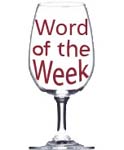Wine Word of the Week: Sediment
By Kori ~ May 29th, 2012.
 This week’s Wine Word of the Week is sediment.
This week’s Wine Word of the Week is sediment.
Official definition from Jancis Robinson’s The Oxford Companion to Wine:
Sediment is the solid material which settles to the bottom of any wine container, whether it be a bottle or a vat, tank, cask, or barrel. This sediment is a very heterogeneous mixture which at the start of wine-making consists mainly of dead yeast cells, the insoluble fragments of grape pulp and skin, and the seeds that settle out of new wine. At subsequent stages it consists of tartrates and, from red wines, phenolic polymers, as well as any insoluble materials added to assist clarification or to facilitate filtration.
Sediments in bottled wines are relatively rare, and usually signal a fine wine that has already spent some years in bottle. So unaccustomed have modern wine consumers become to sediment that many (erroneously) view it as a fault.
Layman’s terms from Kori:
Sediment is the “gunk†that settles to the bottom of a wine bottle. When you pour a wine that contains sediment, you may notice the sediment in your glass as you pour the last bit of wine from a bottle or it might catch around the shoulders of the bottle. While it may not be aesthetically pleasing, there is nothing wrong with a wine that contains sediment. It generally indicates a wine that has been aged a while. To prevent the sediment from ending up in your glass, it is a good idea to pour an older wine (or any wine you suspect contains sediment) through a filter into a decanter before serving.
Filed under: Wine Word of the Week

 Wine Peeps is an independent wine blog dedicated to helping you get the most bang for your buck in wine. We do this through blind tastings of wine from around the world and calculations of
Wine Peeps is an independent wine blog dedicated to helping you get the most bang for your buck in wine. We do this through blind tastings of wine from around the world and calculations of 











I drink my fair share of older wines, and I have to say that the Bordeaux style bottles with the nice pronounced shoulders in them make it easy to pour or decant without a filter since you can capture most of that sediment in the shoulder. Those pesky Rhone bottles though really grind my gears. They don’t have that nice shoulder in them so those are the ones I have to filter or else I drink the grit.
Not filtering wines before bottling seems to be a stylistic choice that many Washington winemakers are doing now. I’ve seen on many bottles “Unfined and unfiltered”, and the sediment in them at such a young age can attest to it. I had a 2009 Cabernet Sauvignon from a Walla Walla winery and there was as much sediment in that bottle as the 1998 Cab I had the other night. I don’t know what point they’re trying to make by doing this, but it’s a little bit annoying to have to filter the last 4 oz. of a brand new wine. Perhaps I’m just getting the “bottom of the barrel” bottles, but still…
Hello this is Alex from the wine forum http://www.winebasic101.com. No one likes sediment in there wine. I’m a home brewer filtering your wine is one of the most important steps you should not forget. You can have a great wine but if there apperence is not there then no one will drink the wine.
Troy and Alex,
Great points. While there is nothing technically wrong with having sediment in a wine, most consumers find it off-putting, especially in younger wines. It is a stylistic choice for some winemakers; however, most people want to be able to just open up a bottle and drink it. Just another one of those things that keeps the world of wine interesting. Cheers!